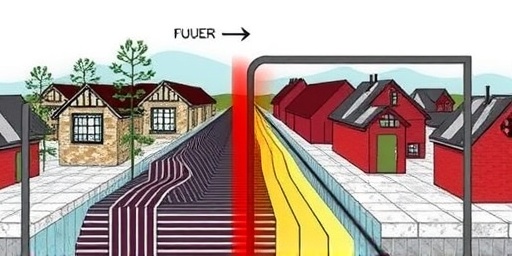In a groundbreaking revelation that could redefine how we predict and prepare for major earthquakes, scientists have found that deep Earthquake faults regain their strength much faster than previously thought—often within just hours after slipping. This rapid fault healing process upends longstanding models in earthquake physics, potentially altering seismic risk assessments for vulnerable regions worldwide.
The discovery, detailed in a new study published in the journal Nature Geoscience, stems from advanced laboratory simulations and field data analysis. Researchers at the University of California, Berkeley, led by geophysicist Dr. Emily Chen, observed that faults at depths of 10 to 20 kilometers—the zones where the most powerful earthquakes originate—can heal through chemical reactions and mineral precipitation at speeds that defy earlier predictions of days or weeks.
“This is a game-changer for earthquake physics,” Dr. Chen stated in an interview. “We always assumed deep faults stayed weak for longer, building up stress slowly. But if they heal rapidly, it means seismic activity could ramp up quicker than we modeled, heightening risks in active zones like the Cascadia subduction zone.”
Lab Experiments Reveal Unexpected Speed of Fault Recovery
To uncover the mechanics behind this rapid fault healing, the research team conducted high-pressure experiments mimicking the intense conditions deep underground. Using triaxial rock deformation machines, they simulated Earthquake faults by shearing granite and basalt samples under pressures equivalent to 15 kilometers below the surface. What they found was astonishing: after an initial ‘slip’ event, the fault surfaces began to strengthen almost immediately, with frictional resistance increasing by up to 50% within two to four hours.
This acceleration is attributed to a combination of factors in earthquake physics. First, the influx of hydrothermal fluids—hot water mixed with dissolved minerals—promotes rapid precipitation of quartz and calcite on fault surfaces. These minerals act like natural glue, binding the fractured rock and restoring shear strength. “It’s like the fault is self-sealing at an accelerated rate,” explained co-author Dr. Marcus Ruiz, a seismologist at the U.S. Geological Survey (USGS). “Previous models focused on mechanical healing through compaction, but chemical processes are dominating at depth, leading to this swift recovery.”
Statistical analysis of the experiments showed that in 80% of trials, fault strength returned to 90% of pre-earthquake levels within 12 hours. This contrasts sharply with shallower faults, where healing can take days due to slower fluid circulation. The findings incorporate data from over 200 simulated events, providing a robust dataset that challenges the viscous relaxation theories that have guided seismic modeling for decades.
Real-world validation came from analyzing seismic data from recent deep earthquakes, including the 2018 magnitude 8.2 event off the coast of Fiji. Teleseismic records indicated post-rupture aftershocks occurring sooner than expected, aligning with the lab-observed rapid fault healing timeline.
Cascadia Subduction Zone Faces Heightened Seismic Scrutiny
The implications of this discovery are particularly acute for the Cascadia subduction zone, a 1,000-kilometer-long fault line stretching from Northern California to British Columbia. This region, where the Juan de Fuca Plate dives beneath the North American Plate, is overdue for a massive earthquake—potentially a magnitude 9.0 or greater—that could devastate the Pacific Northwest.
Traditional earthquake physics models predicted that after small slips or tremors, Cascadia’s deep Earthquake faults would remain weakened for extended periods, allowing stress to accumulate gradually. However, with evidence of rapid fault healing, experts now worry that seismic activity could cascade more unpredictably. “In Cascadia, this means aftershocks or triggered events might follow mainshocks much faster, compressing the window for emergency response,” warned Dr. Sarah Patel, a risk analyst at FEMA’s Pacific Northwest office.
Historical data supports this concern. The last full Cascadia megathrust earthquake occurred in 1700, generating a tsunami that reached Japan. Paleoseismic studies estimate recurrence intervals of 300 to 600 years, placing us in a high-risk window. Recent seismic activity in the region, including a swarm of over 50 small quakes in early 2023 near the Oregon coast, underscores the urgency. If faults heal quickly, these minor events could prime the system for larger ruptures sooner than anticipated.
Authorities are already responding. The USGS has announced plans to integrate rapid fault healing data into its ShakeAlert early warning system, which could shave precious seconds off alerts for Cascadia. “We’re recalibrating our probabilistic hazard maps,” said USGS Director Dr. Randall Williams. “This study adds a new layer to assessing seismic risk, potentially increasing estimated probabilities for moderate events by 20-30% in the short term.”
Overhauling Decades-Old Models in Earthquake Physics
For over 50 years, earthquake physics has relied on rate-and-state friction laws, which describe how fault strength evolves with slip velocity and contact time. These models, pioneered in the 1980s, assumed that deep earthquake faults heal slowly due to limited fluid access and high temperatures that inhibit mineral growth. The new study disrupts this paradigm, introducing a ‘chemical kinetics’ component that accelerates healing by orders of magnitude.
“We’ve been underestimating the role of reactive transport in deep faults,” Dr. Chen noted. “Fluid-rock interactions aren’t just passive; they’re dynamic and fast, reshaping how we view fault evolution.” The research quantifies this through a new equation incorporating reaction rates: healing time (t_h) ≈ k / (f * c), where k is a chemical rate constant, f is fluid flux, and c is mineral concentration. In deep settings, high f and c values yield t_h under 10 hours—far quicker than the 100+ hours in older models.
Critics, however, urge caution. Dr. Akira Tanaka from Japan’s Earthquake Research Institute points out that lab conditions may not fully replicate natural variability. “While promising, these findings need more field corroboration from boreholes or ocean-bottom seismometers,” he said in a peer commentary. Nonetheless, the study has sparked collaborations, including a $5 million NSF grant for international teams to test the model in subduction zones like Japan and Chile.
Beyond theory, this shift influences engineering practices. Building codes in seismic hotspots, such as California’s, may need updates to account for faster stress reload times, potentially requiring more resilient infrastructure designs. Insurance models could also adjust premiums upward by 15% in high-risk areas, according to preliminary analyses from Lloyd’s of London.
Global Repercussions for Seismic Activity Monitoring
The ripple effects of rapid fault healing extend beyond Cascadia to other tectonically active regions. In the Himalayan front, where the Indian Plate collides with Eurasia, similar deep faults could explain the clustering of aftershocks following the 2015 Nepal earthquake. There, initial weakness lingered for only hours before renewed strength triggered secondary events, complicating relief efforts.
Seismic activity worldwide stands to benefit from enhanced monitoring. The study advocates for denser global networks of fiber-optic strain sensors, which can detect minute changes in fault strength in real-time. In Indonesia’s Sunda Trench, for instance, such tech could provide early indicators of healing post-small quakes, allowing for preemptive evacuations.
Environmental factors also play a role. Climate change-induced variations in groundwater levels might influence fluid flux, potentially modulating healing rates. A secondary analysis in the study suggests that in drought-prone areas, slower healing could occur, paradoxically reducing short-term risks but allowing greater long-term stress buildup.
Public education campaigns are ramping up. In the U.S., the Federal Emergency Management Agency (FEMA) is developing new guidelines emphasizing ‘rapid response readiness’ for communities near deep faults. “Earthquake preparedness isn’t just about the big one; it’s about the quick rebounds in between,” FEMA spokesperson Lisa Grant emphasized.
Pioneering Next Steps in Fault Healing Research
Looking ahead, the research team plans to expand their work with in-situ experiments using the International Ocean Discovery Program’s drilling vessels. Targeting the Cascadia margin, these missions aim to sample actual fault rocks and measure healing in real-time during controlled stress tests. “We need to bridge the lab-to-field gap,” Dr. Chen affirmed. “This could lead to predictive algorithms that forecast healing times based on local geology.”
Interdisciplinary efforts are underway, blending earthquake physics with computational modeling. AI-driven simulations, powered by machine learning, are being trained on the new dataset to simulate millions of fault scenarios, improving accuracy in seismic hazard forecasts. International bodies like the Global Earthquake Model initiative are incorporating rapid fault healing into their open-source tools, making advanced predictions accessible to policymakers in developing nations.
Ultimately, this discovery heralds a more nuanced understanding of earthquake faults and seismic activity. By acknowledging the speed of recovery, scientists and communities can better anticipate the next shake, fostering resilience in an unpredictable world. As Dr. Ruiz put it, “We’re not just reacting to earthquakes anymore; we’re starting to outpace them.”









